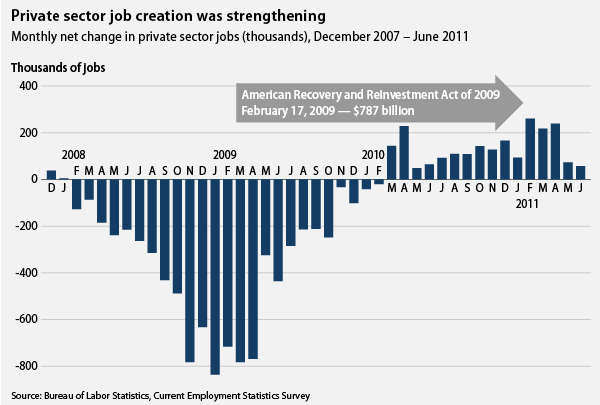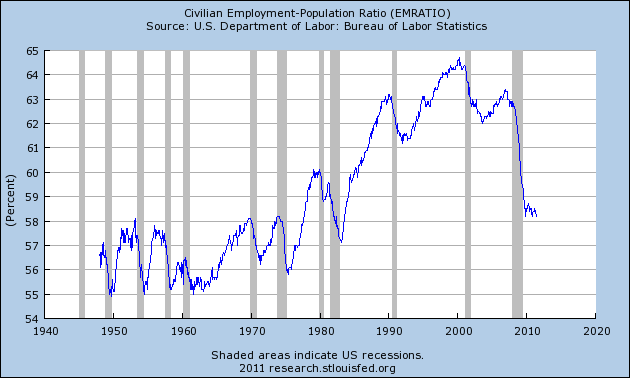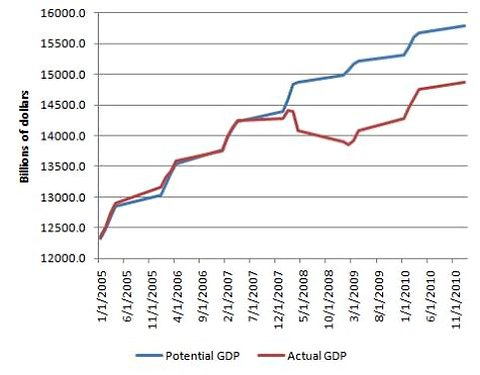|
OCTOBER
2011 UNEMPLOYMENT DATA*
(U.S.
BUREAU OF LABOR STATISTICS)
OFFICIAL
UNEMPLOYMENT: 9.0%
A year earlier, the number of unemployed
persons was 14.9
million, and the jobless rate was 9.7 percent. [BLS]
| White |
8.0% |
| African
American |
15.1% |
| Hispanic |
11.4% |
| Asian** |
7.3% |
| Persons with a disability** |
13.2% |
| Men
20 years and over |
8.8% |
| Women
20 years and over |
8.0% |
| Teens
(16-19 years) |
24.1% |
| Black
teens |
37.8% |
| Officially
unemployed |
13.9
million |
HIDDEN UNEMPLOYMENT
| Working
part-time because can't find a full-time job: |
8.9
million |
| People
who want jobs but are
not looking so are
not counted in official statistics (of which about 2.6 million**
searched for work during the prior 12 months and were available
for work during the reference week.) |
6.4
million |
|
Total:
29.2 million (18.2% of the labor force)
|
Source: http://www.bls.gov/news.release/pdf/empsit.pdf
**Not
seasonally adjusted.
*See Uncommon Sense #4 for an explanation of the unemployment measures.
In addition,
millions more were working full-time, year-round, yet earned less
than the official poverty level for a family of four. In 2010,
the latest year available, that number was 16.8 million, 17.0
percent of full-time, full-year workers (estimated from Current
Population Survey, Bur. of the Census, 9/2011).
In
August, 2011, the latest month available, the number of job openings
was 3.1 million,
little changed from July. Although
the number of job openings remained below the 4.4 million openings
when the recession began in December 2007, the level in August
was 944,000 higher than in July 2009 (the most recent trough)."
Job Openings
and Labor Turnover Estimates, October 12, 2011.+ Thus
there are now more than 9 job-wanters for each available job.

Source:http://www.americanprogress.org/issues/2011/07/jobs_debt[no
longer there]
Employment-population
ratio 1/1948 to 6/2011

The
Waste [of output] by Paul Krugman August 11, 2011, blog
cumulative loss because of recession: $2.8 Tr.

Mass
layoffs:
Employers took 1,495 mass layoff actions in September involving
153,229 workers, seasonally adjusted, as measured by new filings
for unemployment insurance benefits during the month, the U.S.
Bureau of Labor Statistics reported today. Each mass layoff involved
at least 50 workers from a single employer. The number of mass
layoff events in September decreased by 92 from August, and the
number of associated initial claims decreased by 12,318. In September,
376 mass layoff events were reported in the manufacturing sector,
seasonally adjusted, resulting in 39,929 initial claims.
Mass
layoffs: Review
of 2010 BLS, 2/11/11
For all of 2010, employers reported 7,158 extended mass layoff
actions, affecting 1,213,638 workers. Compared to 2009, the number
of events decreased by 39 percent and the number of separations
decreased by 42 percent, the first over-the-year decline for both
measures since 2005. The annual average national unemployment
rate increased from 9.3 percent in 2009 to 9.6 percent in 2010,
and private nonfarm payroll employment decreased by 0.8 percent,
or 914,000.
Industry Distribution of Extended Layoffs
In the private nonfarm economy, manufacturing reported the largest
number of separations, despite reaching a program low in 2010
(with annual data available back to 1996). Construction had the
next highest number of separations. Educational services reported
program highs in both layoff events and separations in 2010.
....
+
"The number of job openings
in August (not seasonally adjusted) increased over the year for
total private and was essentially unchanged for total nonfarm
and government. Several industries experienced an increase over
the year in the number of job openings; the number of job openings
decreased for federal government. The number
of job openings rose in the Midwest."
|

